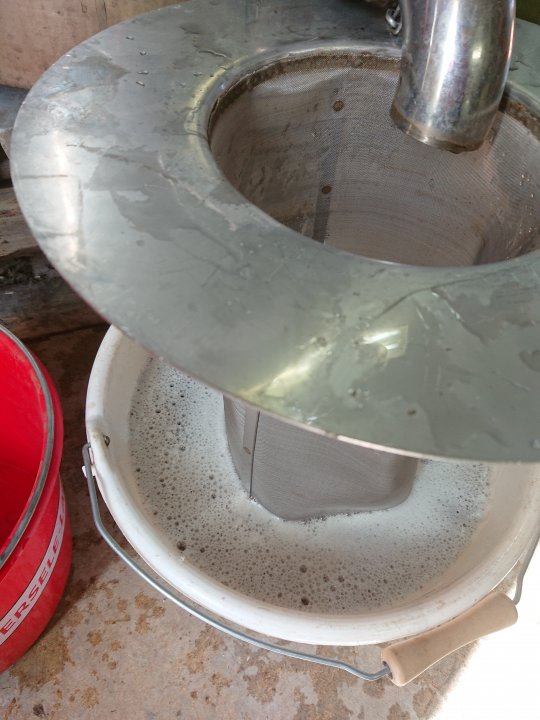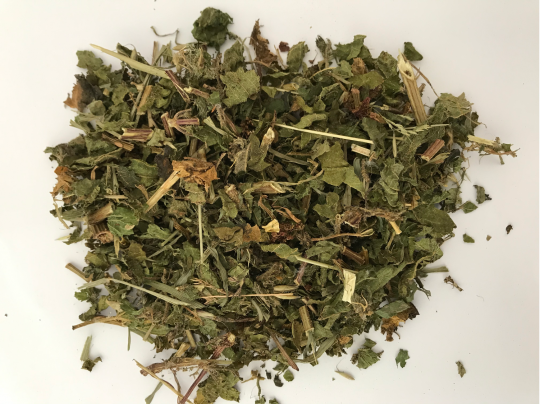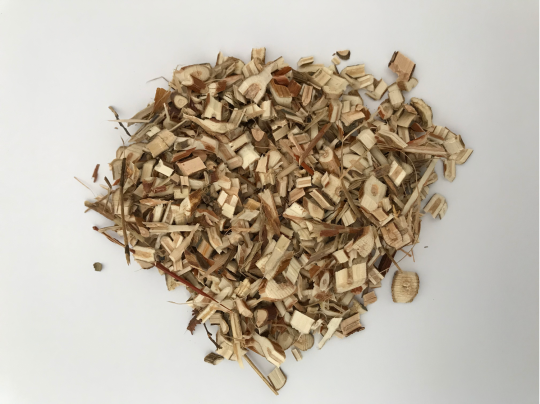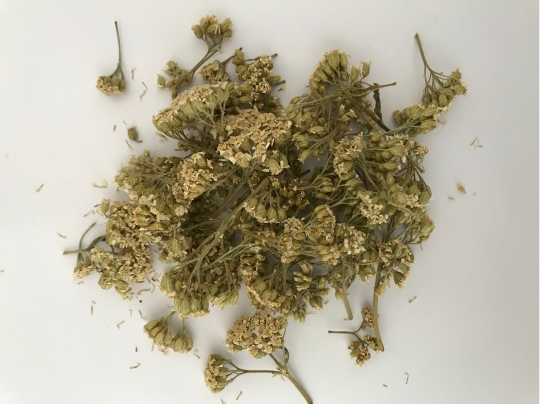Herbal teas are obtained through infusion, which is another method of extracting active ingredients and/or aromas through hot water. Unlike a decoction, infusion involves using the softer plant parts such as leaves, herbs, fruits and/or flowers. Ideally, the liquid (water) is brought to a boil and then poured hot on the plant parts to be extracted. The infusion time can vary depending on the plant, as can the quantities of plants used, but the process remains the same:
2.4.4.b.c Herbal teas
- Cut the plants into coarse pieces
- Submerge these in cold water
- Cover and heat
- Turn off the heat when the water starts to simmer (from 70-80°C for willow and meadowsweet whose active ingredient, salicylic acid, is destroyed above this temperature)
- Keep covered and allow to infuse until cool
- Filter and add to the treatment mixture
OR
- Cut the plants into coarse pieces
- Cover and heat or boil the water to the recommended temperature
- Pour the water over the plant pieces
- Allow to infuse until cool
- Filter and add to the treatment mixture
Once the infusions have been made and cooled for some time in the infuser, the contents are filtered and put into 20 litre containers. The contents are then sprayed as needed (in particular before a frost and after hail or a heat wave) or added to treatment preparations (to combat cryptogamic diseases).
Horsetail infusion
Horsetail can also be infused and used as a tea. It can have a drying effect in addition to its proven anti-mildew effect. It is recommended to apply horsetail in wet conditions. It is more regularly used in decoction form, since horsetail is quite tough and requires soaking before infusion.
Nettle infusion
Nettles are plants that help to regulate and stimulate plant growth and root development. Rich in nitrogen and iron, it also has a fertilizing effect. It has a moderate preventive effect against downy mildew.
Greater effectiveness is observed when the tea is used in a mixture with copper and sulphur, which can enable the doses of these products to be reduced. It is advised to treat during relatively dry conditions. It helps the soil to retain moisture. The recommended dose is 100 g of dry plant/ha with an infusion at 80°C. The action can be combined or alternated with other infusions such as willow or horsetail.
Meadowsweet and willow infusions
Meadowsweet and willow are used to prevent cryptogamic diseases such as downy mildew and have a preventive effect against powdery mildew and botrytis. They also stimulate the vine's natural defences thanks to the presence of salicylic acid. Enhanced effectiveness is observed when the tea is used in a mixture with copper and sulphur, which can reduce the normally required amounts of the latter.
Willow should be used in fairly wet conditions. It is advisable to keep the infusion under 80°C to preserve the benefits of the salicylic acid; doses are 250 g/ha for meadowsweet, 200 g/ha for willow stems and 100 g/ha for willow bark.
Willow and function of the active ingredients: Willow (Salix) contains numerous phenols including salicylate derivatives such as salicylic acid which induces the synthesis of resistance proteins during fungal attacks and helps reduce pathogen sporulation.
Salicylic acid is an intermediary in the plant's defence mechanisms, it enables the synthesis of PR (Pathogen Related) proteins that can attack the pathogen, such as chitinases that break down the cell walls of fungi.
Yarrow herbal tea
Yarrow is rich in salicylic acid and flavonoids (like willow and meadowsweet) as well as iso-valerianic acid. It can be used effectively during periods of very hot weather and against powdery mildew, mixed with sulphur. The recommended dosage for the infusion is 100 g/ha in 30 litres of water per hectare. Yarrow also has cooling properties and can help combat water stress. It is advisable to use it in dry, hot conditions, on plots that are struggling to reduce the risk of scalding. It can also be used during the flowering period to reduce the risk of coulure and encourage good cell multiplication.
Chamomile matricaria infusions
This plant stimulates the exchange of sulphur, calcium and potassium. It favours the formation of sugars for the grapes, with an application during bunch closure/early véraison. In drought conditions, it can be used to combat stress through thermal regulation. Doses of 10 to 50 g/ha can be applied for ripening and up to 60 g/ha of dry plant to treat water stress in 180 to 200 L/ha.
Dandelion infusions
Dandelion flower tea improves plant tissue quality and thus encourages resistance to fungal penetration. Dandelion acts on the metabolism of silica and potassium and on the ripening of the fruit. It is recommended to use a dandelion infusion at a rate of 10 g/ha in 30 l/ha. An application at the 4-5 leaf stage can help the fruit to ripen. An application or two at véraison favours fruit formation. Finally, one or two applications in the event of a drought can help regulate evapotranspiration.
Comfrey tea
Rich in nitrogen, iron, potassium, silica, and rare trace elements such as zinc, manganese and boron, this plant has a stimulating and fungicidal effect. It can be prepared as a herbal tea or a maceration. It can also be used in case of foliar boron deficiency. Applied after the harvest and before the leaves fall, it helps reserves to be replenished and improves budburst the following spring. A dose of 100 g/ha infused or macerated is recommended.
Summary table
| Plant | Plant parts used | Category | Element | Objective(s) | Mecanism(s) | Application | Dosage |
|---|---|---|---|---|---|---|---|
| Horsetail | Entire plant | Basic substance, Biostimulant | Silica, calcium | Humidity control | Drying action, insect repellent, mildew resistance | Bud break or green tip stage until clustered flower buds | |
| Nettle | Leaves or entire plant | Biostimulant | Nitrogen, iron, formic acid | Stimulate, reconstitute | Fertilization, Fortifies the soil's microbial defenses and promotes the plant's defenses | Clustered flower buds | 100 g PS/ha |
| Entire plant | Iron | Promote exchanges | |||||
| Formic acid | |||||||
| Meadowsweet, wicker, willow | Bark or stems | NDS, Primary substance (willow) | Salicylic acid and other polyphenols | Humidity control | Fungus resistant, Stimulator defeRésistance contre les champignons, Stimulate natural defence | Separate floral buds until stage small pea size | 250g/ha for meadowsweet 200g/ha for willow stems 100g/ha for wicker bark |
| Yarrow | Entire plant | Biostimulant, NDS | Sulfur, potassium, salicyllic acid, isovalerian acid, flavonoids, alkaloids | Promotes flowering, Drought control | Disease resistance, coulure control, cell multiplication | Separate floral buds until stage small pea size | 10g PS/ha |
| Camomille | Entire plant, flowers | Biostimulant | Sulfur, potassium, calcium | Support fruit maturation, drought control | Promotes the exchange of elements, favors sugar production for the fruit, thermal regulation | Bunch closure, beginning of veraison, end of veraison in case of drought | 10 to 50g PS/ha for maturation, 50 to 60g PS/ha in case of drought |
| Pissenlit | Flowers, berries | NDS, biostimulant | Silica, calcium | Support fruit maturation, drought control | Improves tissue quality and limits fungus penetration, thermal regulation | 4-5 leaves spread out for maturation | 10g PS/ha |
| Comfrey | Leaves or entire plant | Biostimulant | Potassium, iron, calcium, boron, zinc, silica, manganese, allantoins | Promote flowering | Fertilisation, cicatrization | Following flowering to favor fruit set, after harvest but prior to leaf fall for adequate reserve storage. | 100 g PS/ha |
| Valerian | Entire plant | Biostimulant | Phosphorus, iso-valeric acid | Recovering from trauma | Frost protection, cicatrization following frost | Before or after either a frost or stress event |





